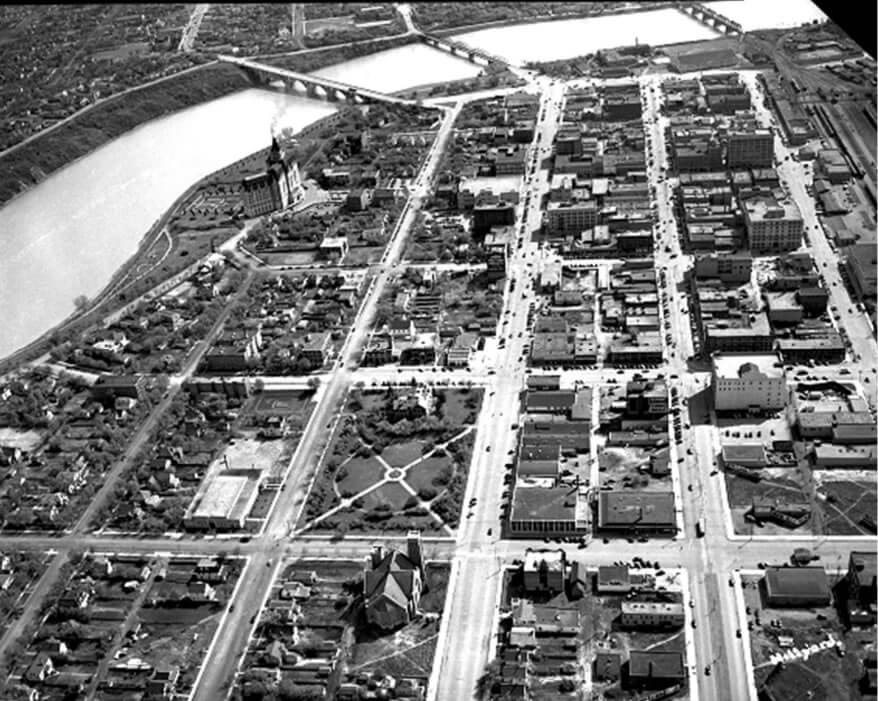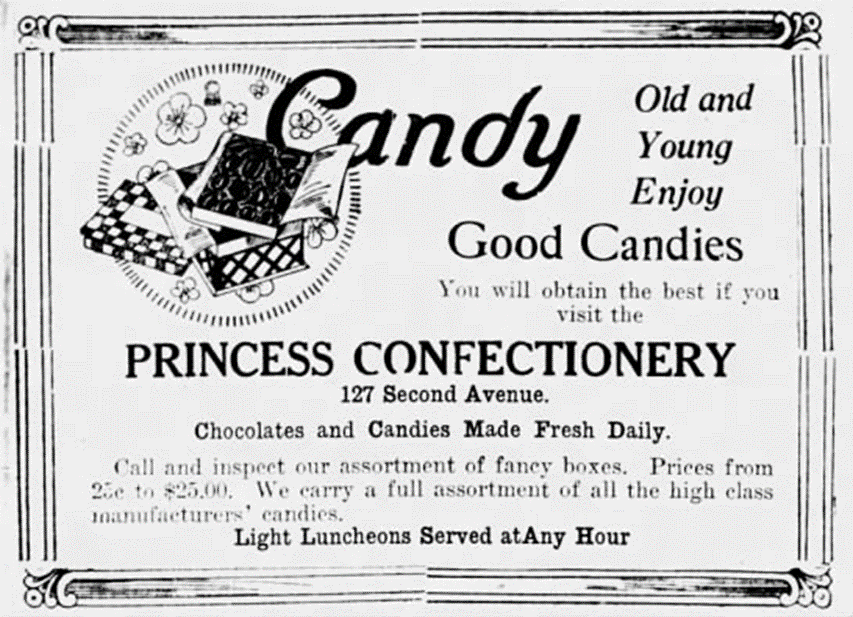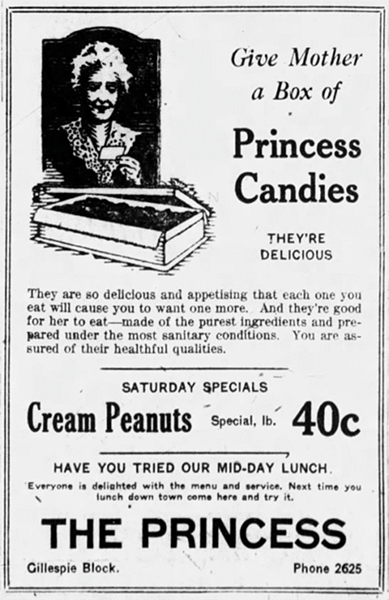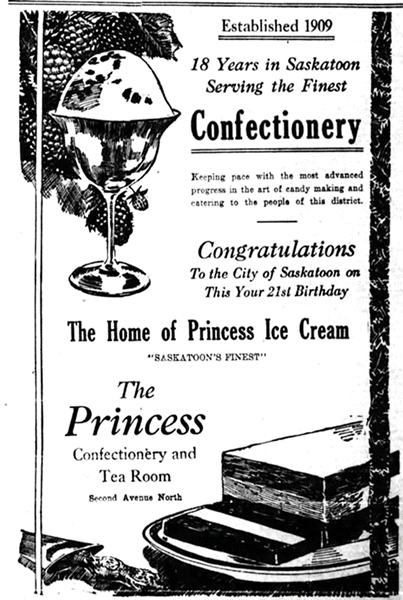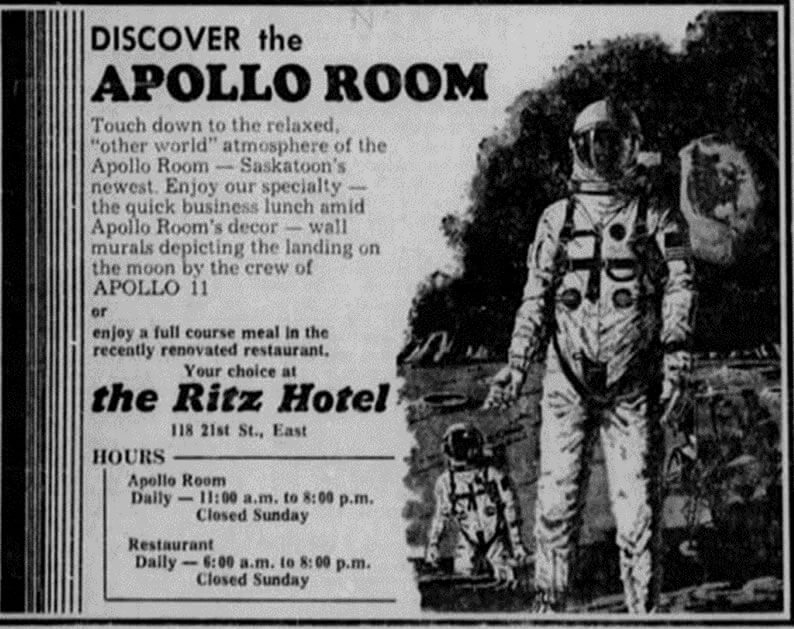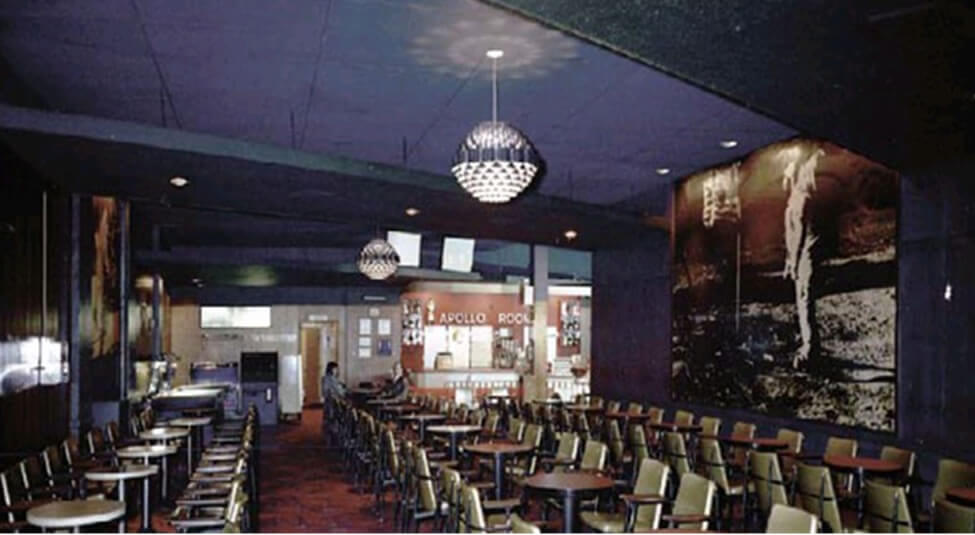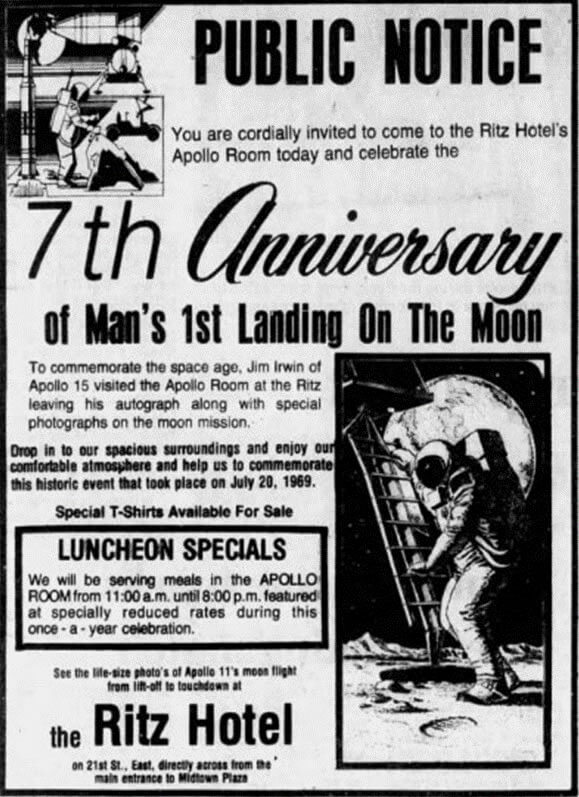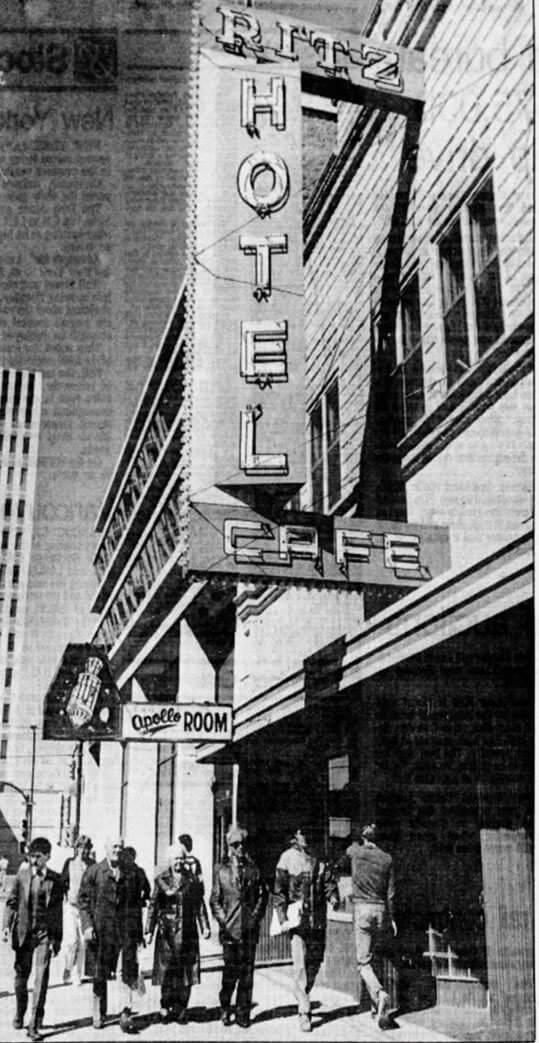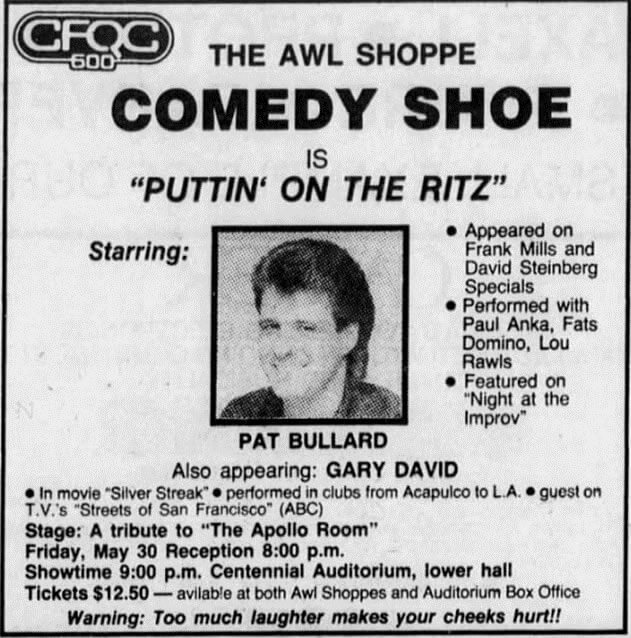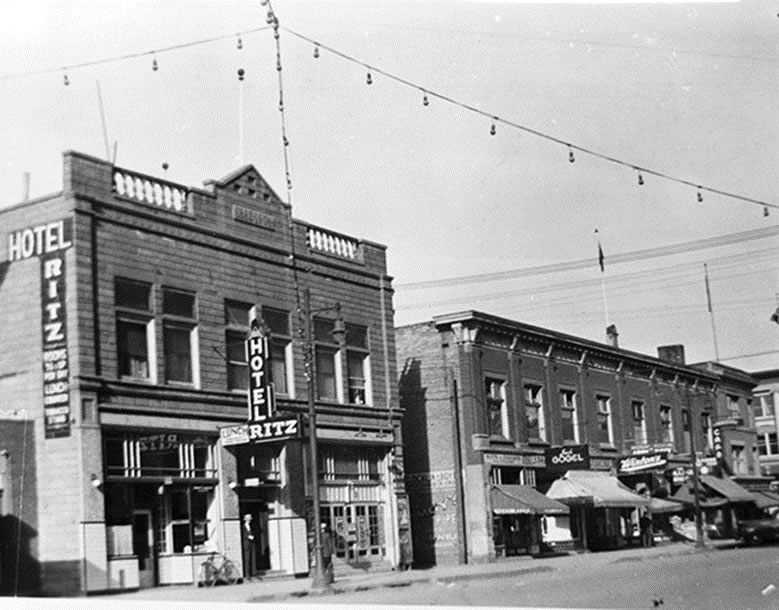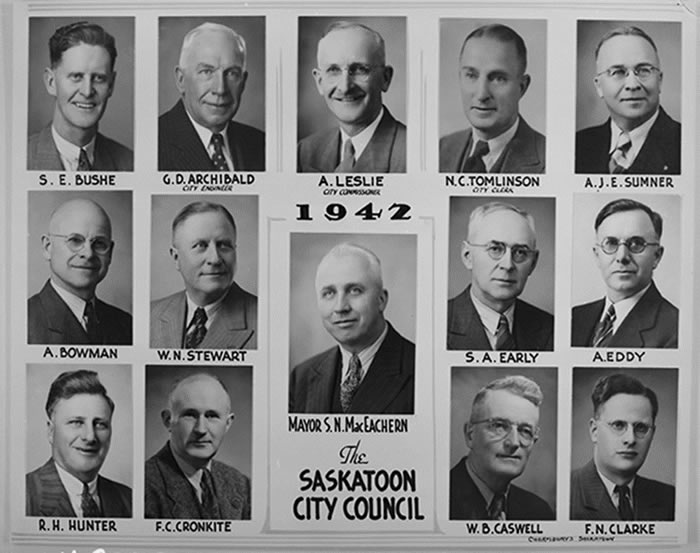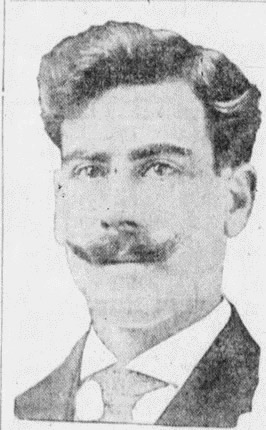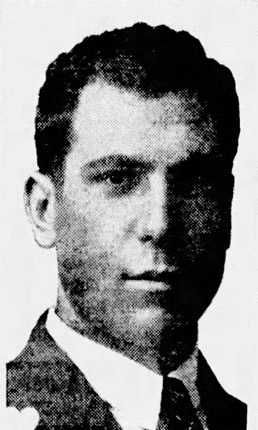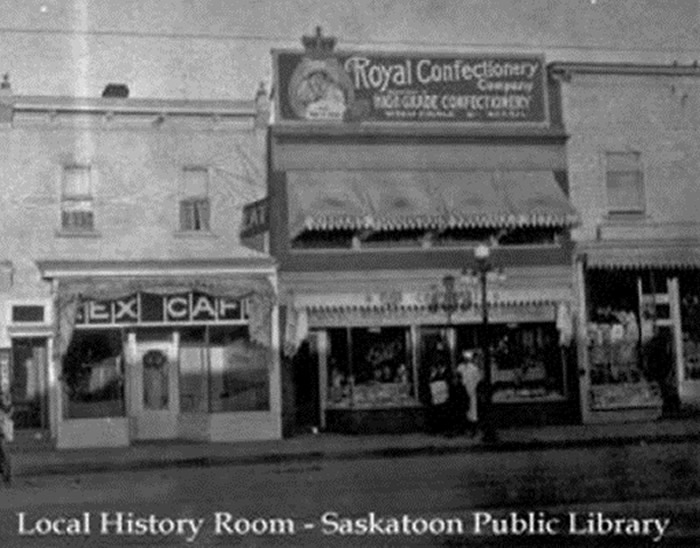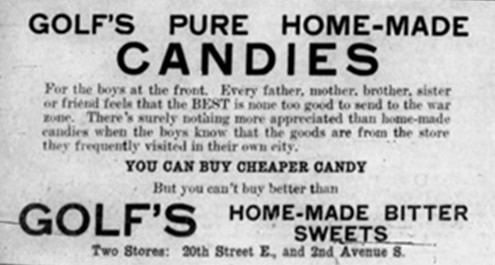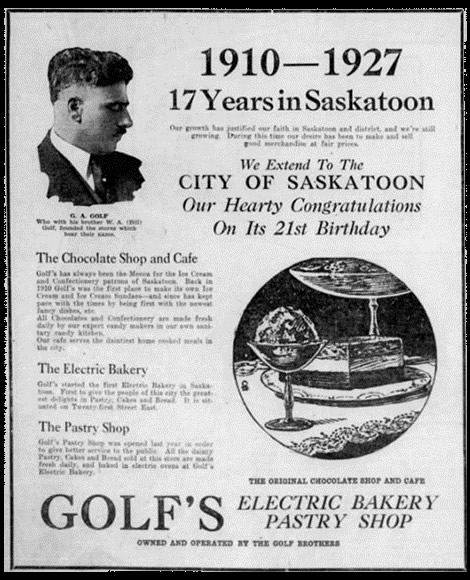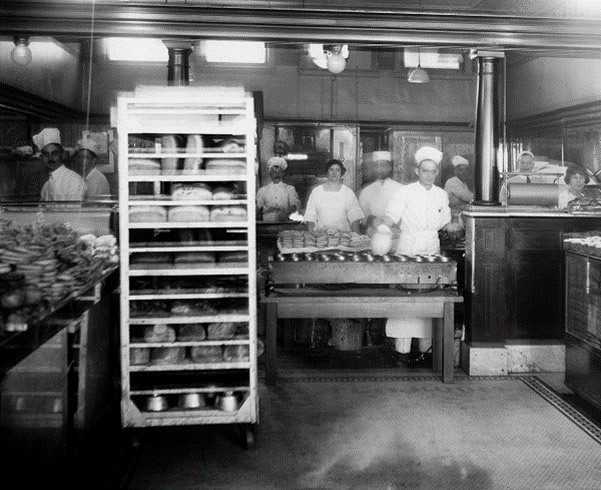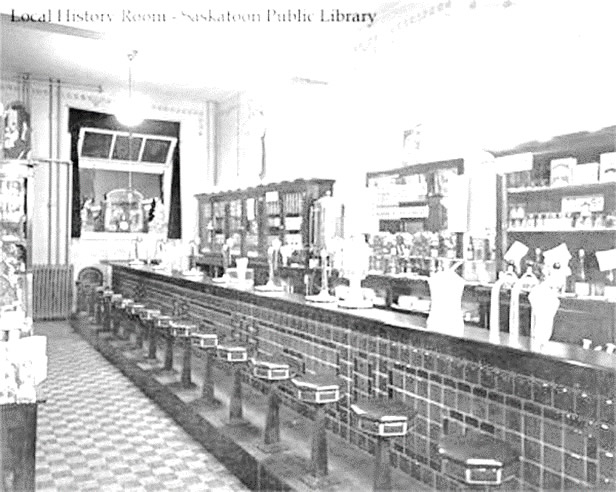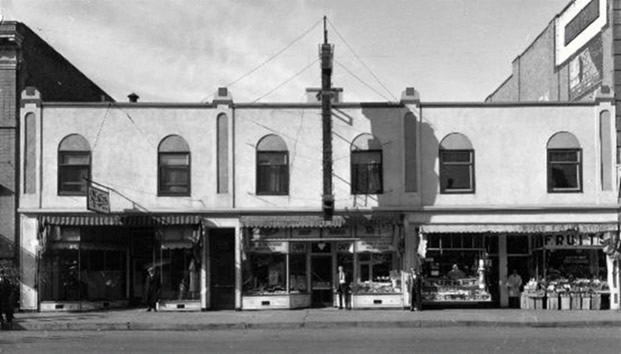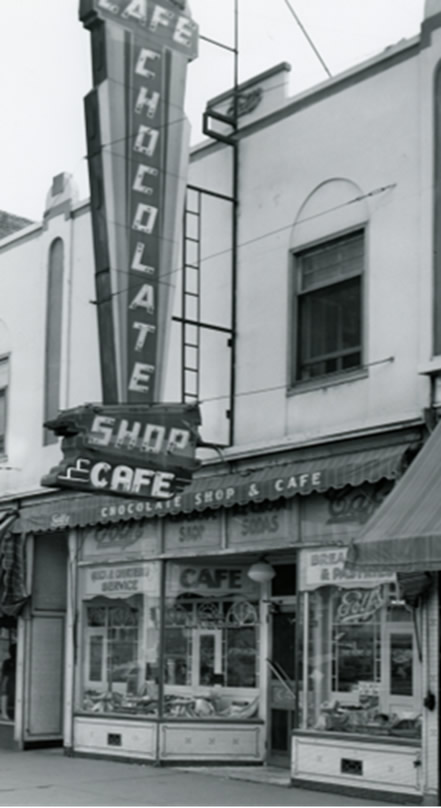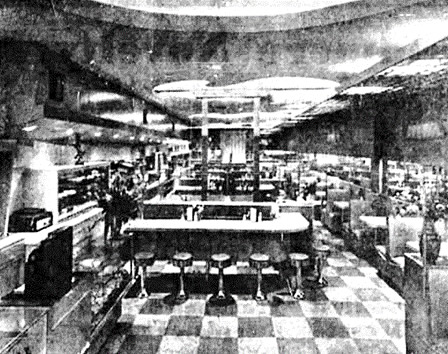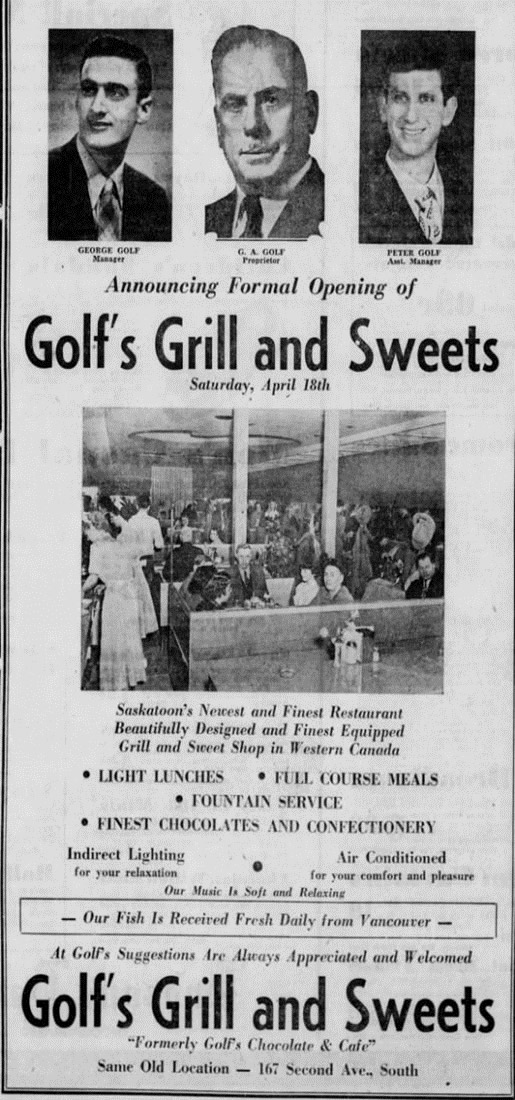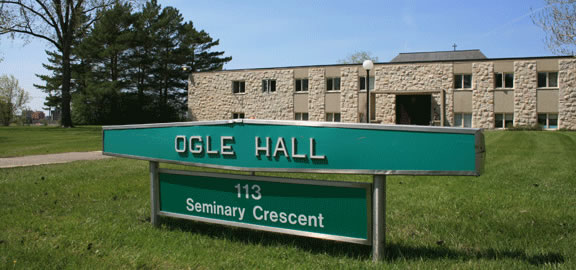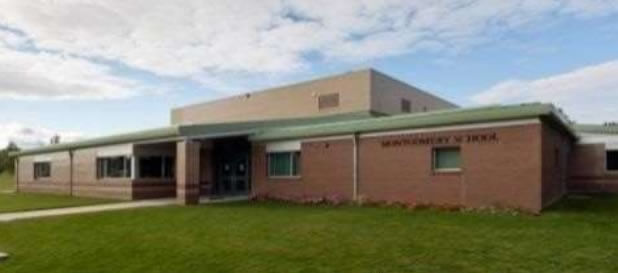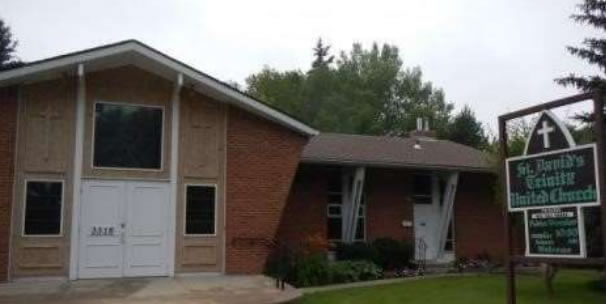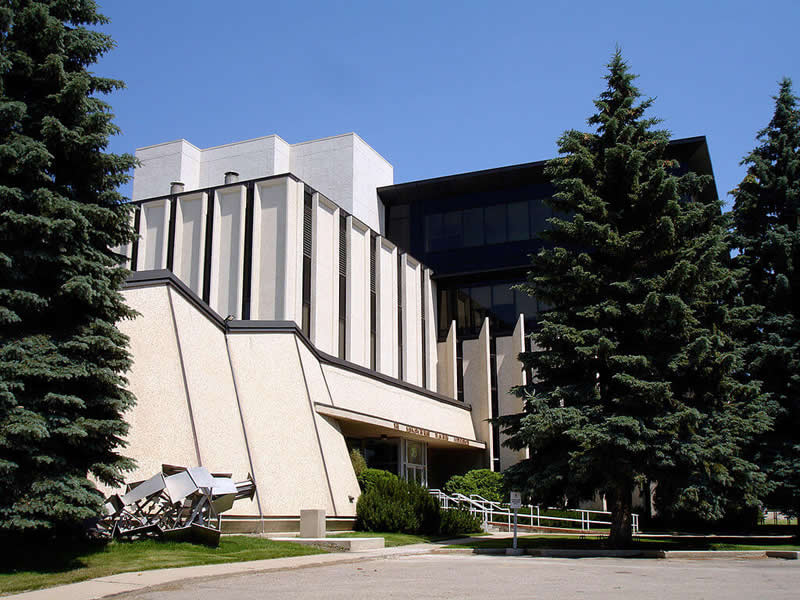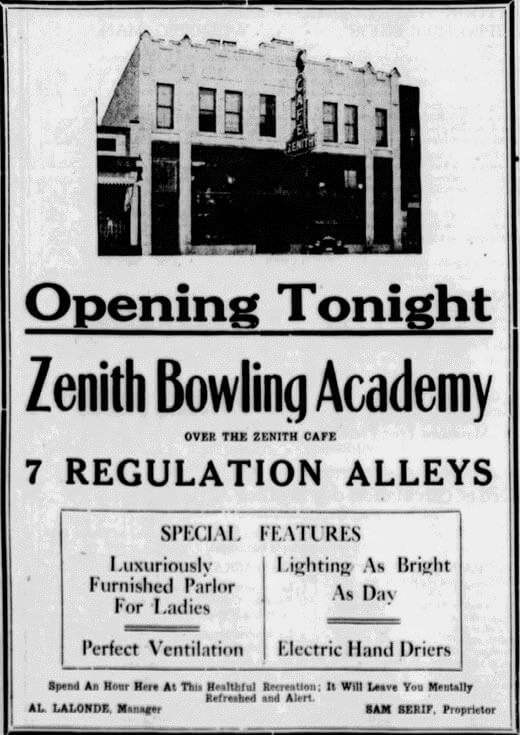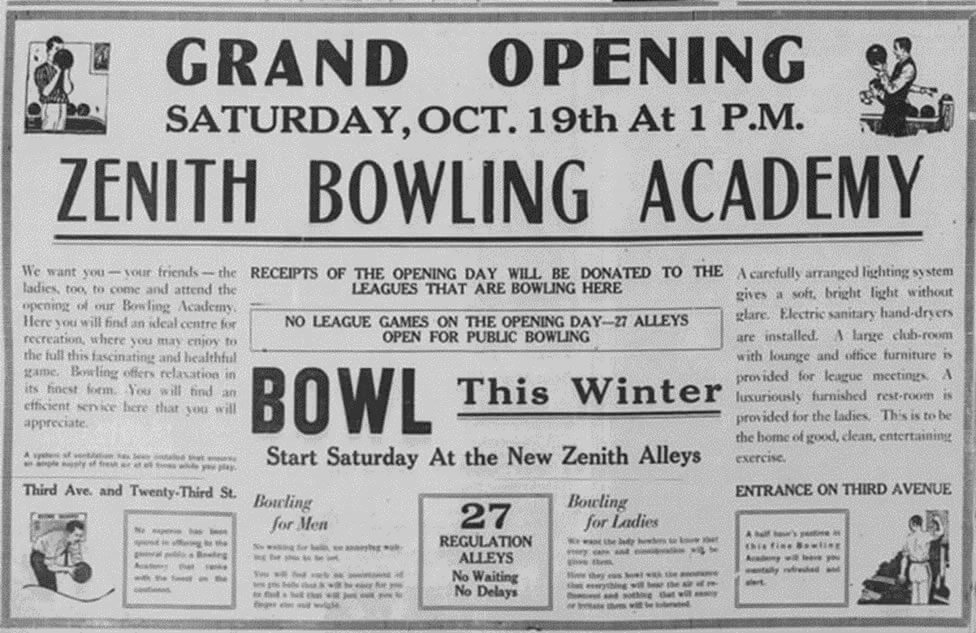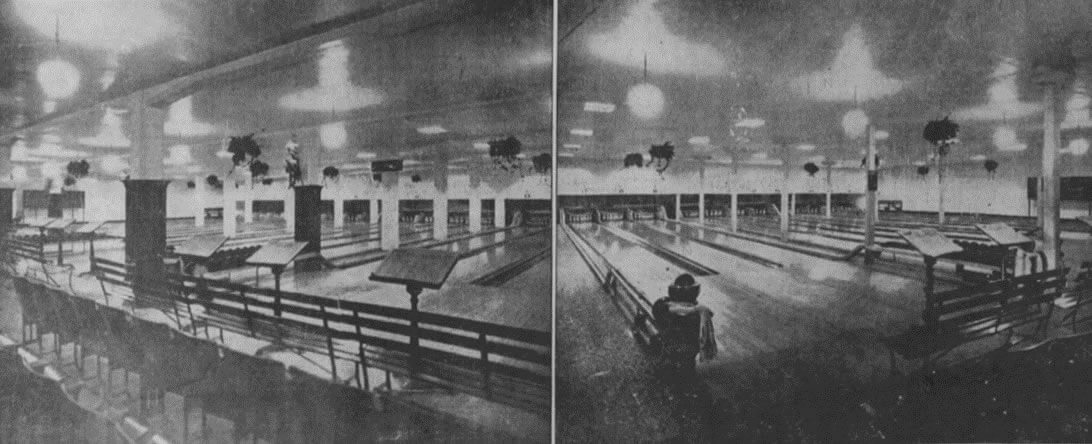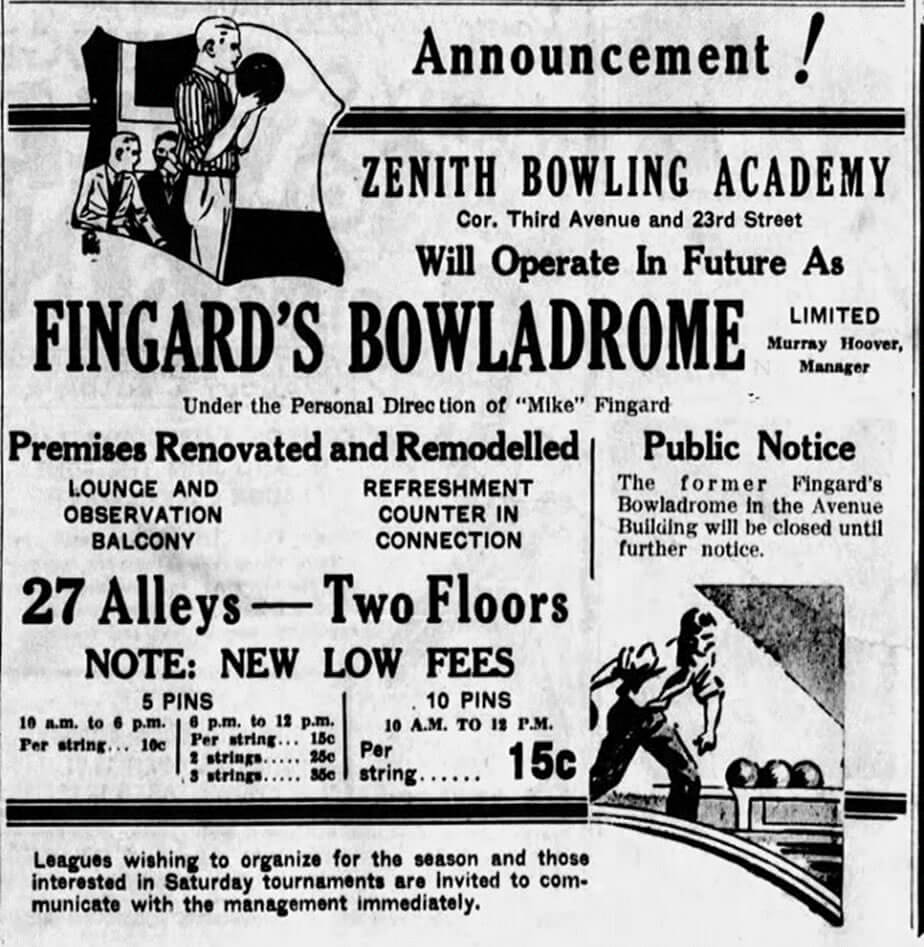Commerce
Aerial view of downtown Saskatoon (ca 1948)
Source: Saskatoon Public Library, Local History Room (B-270)
The story of the businesses of Saskatoon’s early Greek immigrants is more than just the story of restaurants, hotels, and other endeavours. It is the story of families – both immediate and extended. Even though they were competitors, the families that owned and operated these businesses also looked out for each other. Often, there were family connections, through grandparents or through marriage. They also shared a common Greek heritage and immigrant experience in a new land.
This section tells the stories of the businesses that were owned and/or operated in the past by Greek families in Saskatoon. Most of the businesses in this section no longer exist, but there are some which continue the legacy of the founding families but no longer have have Greek ownership or operating connections.
Princess Confectionary and Tea Room (“The Princess”)
127 Second Avenue North (1914 – 1921)
145 Second Avenue North (1921 – 1930 )
Owners/Operators (1914 – circa 1925): George Chronis and Nick Lappas
Owners (circa 1925 – 1929): Gus and George Chronis
Owners/Operators (1930): Charlie Kallops and Nick Lappas
In 1912, the Chronis brothers, George and Gus, worked with the Golf brothers in operating the Royal Confectionery in Saskatoon. In October of that year, the Chronis and Golf brothers were among approximately 50,000 Greek reservists in North America who had been ordered by the Greek government to return and defend their homeland during the Balkan War of 1912-13.
George Chronis returned to Saskatoon and in 1914, with Nick Lappas, opened the Princess Confectionary and Tea Rooms at 127 Second Avenue North. This business included a candy factory that supplied confectionery products to retail businesses in Saskatoon and beyond.
Source: Saskatoon Daily Star, February 28, 1918, p. 14.
By 1920, the Confectionery had expanded to include a tearoom, ice cream parlour, and soda fountain. Light lunches were served in the tearoom. However, the business was centred on the manufacturing and wholesale distribution of candies. By 1921, the business had expanded so much that it had to relocate to new quarters at 145 Second Avenue North, also known as the Gillespie Block.
Source, Saskatoon Daily Star, May 11, 1923, p. 10.
By 1925, Nick Lappas had left his partnership with the Chronis brothers and joined other business partnerships.
The Princess Confectionary and Tea Room continued to prosper under the ownership of the Chronis brothers. In 1929, they purchased the Gillespie building which their Confectionary shared with a clothing store. Plans were underway to undertake renovations, but tragedy struck in November 1929, when George Chronis suddenly died.
Gus sold the business to Charlie Kallops, and Nick Lappas who by 1930 had rebranded the business into the Golden Gate Café. In addition to a full dinner menu, the café continued the Princess’ traditions of candies and teacup readings. Gus continued to own the building into the 1940s. At that time, the restaurant in the building was known as the Cameo Café and was operated by Ted Gardiner.
From the Ritz Beer Parlour to the Apollo Room (Ritz Hotel)
118 – 21st Street East
Owner/operator: The Geatros Family
Following a province-wide plebiscite, the Saskatchewan Legislature passed legislation in 1935 which provided a limited number of licenses, based on population, to hotels to operate by-the-glass beer parlours. The operations were highly regulated. The Ritz Hotel, operated by the Geatros family, was among the first beer parlours licensed in Saskatoon.
The Ritz beer parlour was initially a men-only facility. In 1960, renovations were undertaken to expand and convert the facility into a license beverage room that sold more varieties of alcohol and that could accommodate a section for “women and escorts”.
In 1970, the beverage room was redecorated with a space theme featuring large mural photographs of the Apollo 15 landing on the moon. According to Diane Stratas (daughter of the William and Effie Geatros) the development of the theme was a family effort: “My sister Mary chose the name Apollo, and my other sister Helen designed the décor.”
The Apollo Room opened at a time when the city’s “bar scene” was changing. According to a long-time customer, the Bessborough Hotel began enforcing stricter dress requirements. Many of the younger drinkers were offended when they were not served because of their appearance and attire; they responded by moving their business to the Ritz. The Apollo Room attracted a diverse clientele – including working-class residents, university students, and members of the city’s gay and lesbian community. The Star-Phoenix described the Apollo Room as the “home of the 21-cent draft and juke box music ranging from country favourites like You’re the Reason my Children are Ugly, to traditional Greek tunes”.
Interior of the Apollo Room (1974)
Source: Saskatoon Public Library, Local History Room (CP-6910-1)
The Apollo room used its outer space theme to promote the business. According to Diane Stratas, “Every July 20, we’d give out souvenirs to celebrate the first time man walked on the moon”. One of the murals was later autographed by astronaut Jim Irwin who walked on the moon during the Apollo 15 mission.
Exterior of the Ritz Hotel, with the sign to the left for the Apollo Room
Source: Saskatoon Star-Phoenix, April 24, 1985, D11
The Ritz Hotel, Café, and Apollo Room closed in 1985, following the death of Effie Geatros. The building was purchased by the Royal Bank of Canada and demolished in 1987.
In 1985, a group former customers purchased several items from the Apollo Room – such as the wall murals, signs tables, chairs, and carpet. The purchasers were the original sponsors of an annual comedy show (“Comedy Shoe”). In 1986, the comedy show’s theme was “Puttin’ on the Ritz”, a cabaret-style tribute to the beverage room. Also, “reunion” events of the Apollo Room’s customers were held in 1987, 1993, and 1994.
Source: Saskatoon Start-Phoenix, May 28, 1986, p. C6.
Researched by Ken Pontikes, December 11, 2021
Sources: Valerie J. Korinek, Prairie Fairies: A History of Queer Communities and People in Western Canada, 1930 – 1985 (Toronto: University of Toronto Press, 2018), p. 162 and Saskatoon Star-Phoenix, April 24, 1985, p. D11; and July 24, 1987, p. B5.

Owners/Operators: Golf Brothers (Gus and Bill)
Gus Golf learned to make candy from his uncle in Aegeon, Greece. He emigrated to the United States in 1904 when he was 21 years old. A year later, he moved to Canada. His 18-year-old brother, Bill, followed in 1907 and together they settled in Saskatoon in 1910.
Shortly after their arrival, the Golf brothers were successfully operating the Royal Confectionery Company. This company was among the first Greek-owned businesses in Saskatoon.
The Royal Confectionary Company operated a candy-making factory in the Hunt Block on 23rd Street. The brothers then moved the factory to a “shack” located on property on Third Avenue that would be later developed into the Ross Block on Twentieth Street in Saskatoon. Demand for its products required the Company to relocate again to a building on the east side of Second Avenue between 20th and 21st Street. The candy factory was on the second floor of the building. A confectionary and ice cream operation were on the ground floor.
In 1915, Royal Confectionary was the “only wholesale confectionary business, including manufacturing, between Winnipeg and the coast” (Saskatoon Daily Star, April 23, 1915, p. 12.) It supplied chocolates and candies to retailers throughout Saskatchewan.
By 1916, the brothers had two retail stores – one at 266 Second Avenue South and another at its 20th Street factory location. A third store, known as Golf’s Tea Room, opened at 134 Twenty-first Street East in 1917. The three outlets sold candies and chocolates manufactured in the Golf family’s candy factory, which was relocated to the second floor of their building on 21st Street. The factory was supplying chocolates and candies to retailers throughout Saskatchewan. Approximately 30 people were employed in these stores and in the factory.
Golf’s Confectionery and Royal Confectionery Company Billboard, 266 Second Avenue South (circa 1917)
Source: Saskatoon Public Library, Local History Room (LH-7118)
Source: Saskatoon Daily Star, May 11, 1915, p. 10.
Source: Saskatoon Daily Star, November 6, 1916, p. 2.
Golf’s Chocolate Shop and Cafe was established in 1922, along with Golf’s Electric Bakery and Golf’s Pastry Shop. The Chocolate Shop was located on Second Avenue (near the corner of Second Avenue and Twenty-first Street), the Pastry Shop was next door, and the Electric Bakery (Saskatoon’s first bakery using electric ovens) was around the corner on Twenty-First Street.
Golf’s Electric Bakery, 1923
Source: Saskatoon Public Library, Local History Room (PH-2016-30)
In the 1930s, Gus moved his family to Greece where he felt, the climate would better suit the health challenges faced by one of his daughters. In 1932, Bill Golf died. Gus returned to travel frequently between his family in Greece and his businesses in Saskatoon. When World War II broke out, Gus was in Saskatoon but was separated from the rest of his family who were still in Greece. A family reunification in Saskatoon did not occur until 1946.
Golf Block, 167 Second Avenue South, circa 1933
Source: Saskatoon Public Library, Local History Room (A-222)
In 1953, Gus Golf, with his three sons George, Frank, and Peter, renovated and rebranded the Chocolate Shop and Café into Golf’s Grill and Sweets. In 1954, a banquet and private dining room (“Zebra Room” was added and the restaurant was renamed as Golf’s Restaurant. Another banquet room (“Terra Bamboo Room” was added in 1957. Mr. Golf’s son, Peter, carried on the family business. He subsequently opened several businesses in Saskatoon and Regina, including Dog ‘n Suds, Golf’s Steak House, Putt ‘n Bounce, Fuddruckers, and Golf’s Car Wash.
Golf’s Grill and Sweets, 1953
Source: Saskatoon Star-Phoenix, April 17, 1953, p. 15.
Researched by Ken Pontikes (October 31, 2023).
Tinos Kortes Registered Architect (717 Victoria Avenue)
Owner: Tinos Kortes
Tinos Kortes was a well-known architect in Saskatoon who received his Bachelor of Architecture
degree in 1949 from the University of Manitoba. He initially worked as an architect with Webster &
Gilbert, an architectural firm in Saskatoon. Shortly afterwards, he established his own firm which he
operated until his retirement in 1987. He was a member of the Saskatchewan Association of Architects,
as well as the Royal Architectural Institute of Canada.
Mr. Kortes designed many buildings in Saskatoon. These included educational facilities (Lorne
Haselton Elementary School which is now occupied by the Saskatchewan Abilities Council,
Montgomery Elementary School, Ogle Hall which was formerly St. Pius X Seminary at the University
of Saskatchewan), recreational facilities (Gordie Howe Kinsmen Arena), office buildings
(Saskatchewan Teachers Federation Building, Remai Building), churches (St. David’s Trinity United
Church), restaurants (Jay Dees, The Suburban), and residences.
Researched by Ken Pontikes (October 31, 2023).
Zenith Bowling Academy
136 Second Avenue North and 157 Third Avenue North
Owner/operator: Sam Serif (1928 – 1932)
In 1928, the Greek-born owner of the Zenith Café (136 Second Avenue North), Sam Serif, converted the second-floor ballroom in his building into a five-pin bowling alley. The Zenith Café continued to operate on the main floor.
Sam was responding to the growing popularity of bowling in Saskatoon as a recreational activity. The public – men and women, young and old – responded enthusiastically to the modern, clean, and well-ventilated facility. According to an article in the Star-Phoenix: “From one of the minor amusements with a hundred or so people playing in one or two leagues to more than eight hundred playing . . . [this reflects] the rapid advancement bowling has made in Saskatoon in the past few years.” (Saskatoon Star-Phoenix, October 18, 1929, p. 22.) The Star-Phoenix suggested that the bowling lanes at the Zenith Café “marked the beginning of a revival of bowling in Saskatoon” (Saskatoon Star-Phoenix, November 7, 1929, p. 11).
Saskatoon Star-Phoenix, October 25, 1928, p. 15
The bowling lanes proved to be popular and Sam decided to expand his operation by building a new bowling facility at the south-west corner of Third Avenue and Twenty-third Street (157 Third Avenue North). The reinforced-concrete building and its interior equipment cost approximately $185,000. The facility consisted of a one-storey structure (110 x 120 feet) with a basement. The 27-lane facility opened in October 1929. Eleven alleys were located on the first floor, with another 16 in the basement. Five hundred spectators could be accommodated in the basement alleys and another 250 on the first floor. Around 75 people were employed in the facility during the winter months.
When it opened, the new facility was the home of 190 teams in fifteen leagues. A “board room” was also included in the building; this room was made available as a meeting space for sports clubs. A thirty-foot lunch counter operated in the basement.
By December 1929, the popularity of bowling in Saskatoon supported two large (the Zenith Bowling Academy and Mike Fingard’s 18-lane Bowladrome in the basement of the Avenue Building) and two smaller bowling establishments, providing a total of 54 lanes. Approximately 50 leagues, accounting for over 400 teams and 2,000 bowlers, participated competitively. Another 2,000 people were recreational bowlers and not affiliated with competitive teams. The focus of the sport shifted from ten-pin to five-pin bowling and consequently, attracted more women and families. In 1929, 60% of bowlers in Saskatoon were women. The Star-Phoenix also reported that “the existing bowling alleys are crowded to capacity and sometimes people are turned away because of a lack of alleys on which to play the game” (Saskatoon Star-Phoenix, December 31, 1929, p. 78).
Despite the rapid growth in bowling’s popularity, Sam Serif faced financial difficulties in operating his Bowling Academy. In the spring of 1932, he was forced to sell the facility. Mike Fingard purchased and renamed the facility as Fingard’s Bowladrome. The operation in the Avenue Building was closed.
Source: Saskatoon Star-Phoenix, September 2, 1933, p. 13.
In 1956, the Fingard family subsequently sold the facility to John Rak. The downtown facility was renamed as Rak’s Bowladrome and continued to operate until 1983 when it was closed.
Researched by Ken Pontikes, December 7, 2023.
Sources: Saskatoon Star Phoenix August 21, 1928, p. 3; October 25, 1928, p. 15; June 21, 1929, p. 11; October 18, 1929, p. 22; November 7, 1929, p. 11; November 5, 1929, p. 15; December 31, 1929, p. 16, 78, and 80; October 19, 1931, p. 10; February 27, 1932, p. 20; August 20, 1932, p. 5; September 2, 1933, p. 13; April 16, 1983, p. 3; and February 12, 1933, p. 3.
